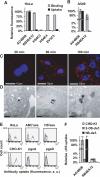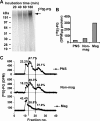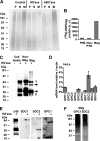ScFv antibody-induced translocation of cell-surface heparan sulfate proteoglycan to endocytic vesicles: evidence for heparan sulfate epitope specificity and role of both syndecan and glypican
- PMID: 19783663
- PMCID: PMC2781711
- DOI: 10.1074/jbc.M109.036129
ScFv antibody-induced translocation of cell-surface heparan sulfate proteoglycan to endocytic vesicles: evidence for heparan sulfate epitope specificity and role of both syndecan and glypican
Abstract
Cellular uptake of several viruses and polybasic macromolecules requires the expression of cell-surface heparan sulfate proteoglycan (HSPG) through as yet ill defined mechanisms. We unexpectedly found that among several cell-surface-binding single chain variable fragment (scFv) anti-HS antibody (alphaHS) clones, only one, AO4B08, efficiently translocated macromolecular cargo to intracellular vesicles through induction of HSPG endocytosis. Interestingly, AO4B08-induced PG internalization was strictly dependent on HS 2-O-sulfation and appeared independent of intact N-sulfation. AO4B08 and human immunodeficiency virus (HIV)-Tat, i.e. a well known cell-penetrating peptide, were shown to compete for the internalizing PG population. To obtain a more detailed characterization of this pathway, we have developed a procedure for the isolation of endocytic vesicles by conjugating AO4B08 with superparamagnetic nanoparticles. [(35)S]sulfate-labeled HSPG was found to accumulate in isolated, AO4B08-containing vesicles, providing the first biochemical evidence for intact HSPG co-internalization with its ligand. Further analysis revealed the existence of both syndecan, i.e. a transmembrane HSPG, and glycosyl-phosphatidyl-inositol-anchored glypican in purified vesicles. Importantly, internalized syndecan and glypican were found to co-localize in AO4B08-containing vesicles. Our data establish HSPGs as true internalizing receptors of macromolecular cargo and indicate that the sorting of cell-surface HSPG to endocytic vesicles is determined by a specific HS epitope that can be carried by both syndecan and glypican core protein.
Figures






Similar articles
-
Heparan sulfate proteoglycans (HSPGs) and chondroitin sulfate proteoglycans (CSPGs) function as endocytic receptors for an internalizing anti-nucleic acid antibody.Sci Rep. 2017 Oct 30;7(1):14373. doi: 10.1038/s41598-017-14793-z. Sci Rep. 2017. PMID: 29085061 Free PMC article.
-
Cancer cell exosomes depend on cell-surface heparan sulfate proteoglycans for their internalization and functional activity.Proc Natl Acad Sci U S A. 2013 Oct 22;110(43):17380-5. doi: 10.1073/pnas.1304266110. Epub 2013 Oct 7. Proc Natl Acad Sci U S A. 2013. PMID: 24101524 Free PMC article.
-
Selection of mutant CHO clones resistant to murine gammaherpesvirus 68 infection.Virology. 2008 Apr 10;373(2):376-86. doi: 10.1016/j.virol.2007.12.004. Epub 2008 Jan 14. Virology. 2008. PMID: 18191980
-
The role of the glypican and syndecan families of heparan sulfate proteoglycans in cardiovascular function and disease.Am J Physiol Cell Physiol. 2022 Oct 1;323(4):C1052-C1060. doi: 10.1152/ajpcell.00018.2022. Epub 2022 Aug 22. Am J Physiol Cell Physiol. 2022. PMID: 35993518 Review.
-
Heparan sulfate proteoglycan as a cell-surface endocytosis receptor.Matrix Biol. 2014 Apr;35:51-5. doi: 10.1016/j.matbio.2013.10.004. Epub 2013 Oct 18. Matrix Biol. 2014. PMID: 24145152 Review.
Cited by
-
Binding of the human antioxidation protein α1-microglobulin (A1M) to heparin and heparan sulfate. Mapping of binding site, molecular and functional characterization, and co-localization in vivo and in vitro.Redox Biol. 2021 May;41:101892. doi: 10.1016/j.redox.2021.101892. Epub 2021 Feb 10. Redox Biol. 2021. PMID: 33607500 Free PMC article.
-
ScFv anti-heparan sulfate antibodies unexpectedly activate endothelial and cancer cells through p38 MAPK: implications for antibody-based targeting of heparan sulfate proteoglycans in cancer.PLoS One. 2012;7(11):e49092. doi: 10.1371/journal.pone.0049092. Epub 2012 Nov 9. PLoS One. 2012. PMID: 23152853 Free PMC article.
-
Microglia: Friend and foe in tauopathy.Prog Neurobiol. 2022 Sep;216:102306. doi: 10.1016/j.pneurobio.2022.102306. Epub 2022 Jun 14. Prog Neurobiol. 2022. PMID: 35714860 Free PMC article. Review.
-
Heparin increases the infectivity of Human Papillomavirus type 16 independent of cell surface proteoglycans and induces L1 epitope exposure.Cell Microbiol. 2013 Nov;15(11):1818-36. doi: 10.1111/cmi.12150. Epub 2013 May 6. Cell Microbiol. 2013. PMID: 23601855 Free PMC article.
-
The role of syndecan-1 in cellular signaling and its effects on heparan sulfate biosynthesis in mesenchymal tumors.Front Oncol. 2013 Dec 19;3:310. doi: 10.3389/fonc.2013.00310. Front Oncol. 2013. PMID: 24392351 Free PMC article. Review.
References
Publication types
MeSH terms
Substances
LinkOut - more resources
Full Text Sources
Other Literature Sources

